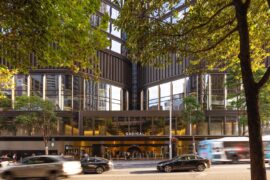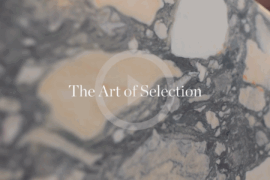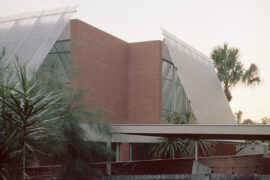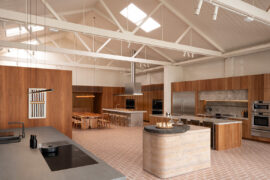Singaporean artist, curator and publisher Michael Lee tells us how urban memory and fiction inspire his work.

October 24th, 2013
Michael Lee is an artist, curator and publisher based in Berlin and Singapore. He researches urban memory and fiction, especially the contexts and implications of loss, transforming his observations into objects, diagrams, situations, curations or texts.
Lee has staged solo exhibitions both in Singapore and overseas, and has participated in many group exhibitions around the world. Some of his most recent accolades include the APBF Signature Art Prize 2011 (People’s Choice Award), conferred by the Singapore Art Museum, and the Young Artist Award (Visual Arts) 2005, given out by the National Arts Council, Singapore.
The artist, who has a Master’s degree in Communication Studies from Nanyang Technological University, talks to us about some of his recent work, including a series of projects for Art Stage 2011 and 2012.
Syonan Fukusou Koujou (Singapore Garment Factory), Singapore, 1944-45, from the series Office Orchitect (2011). At Old Kallang Airport, during Singapore Biennale 2013
Your background is in Communication Studies. What made you decide to embark on a career as an artist?
Every job is a problem. I just think that art is a problem I want to have.
A lot of your work delves into urban memory and fiction, especially the contexts and implications of loss. Why does this interest you?
The birth of writing coincided with the birth of the first city, Sumeria, in 3100 BC, so memory and urban conditions are arguably intrinsically connected. Past lessons can be great teachers as much as they may be haunting ghosts, but a lot of experiences don’t get transmitted to the present due to memory loss, censorship or simply the lack of a means of storage. I’m especially interested in the paradox that the most part of memory involves imagination and fictionalisation. It is important for me to start from the premise that we can no longer be absolute about anything at all. So when I mix fact and fiction in a single work, such as the mind map at Telok Blangah MRT Station, Notes Towards a Museum of Cooking Pot Bay (2010/11), I do it because I see both types of data as having comparable ‘validity’; some facts can appear bizarre and fantastic, while the best stories are grounded in some kind of reality. When I made Office Orchitect (2011), a fictional retrospective exhibition for a failed architect of Singapore, I wanted to give voice to underdogs whose talents and contributions might have been swept under the carpet of official architectural history.
Revision Exercise No. 2 (detail with audience interaction) 2012. At Art Stage 2012, Marina Bay Sands, Singapore
Can you tell us what you presented at Art Stage in 2011 and 2012?
I showed the full set of Second-Hand City (2010-11) prints and made the interactive installation, Revision Exercise No. 2 (2012), during the 2011 and 2012 editions of Art Stage respectively.
Revision Exercise No. 2 was an interactive mural. A large-scale digital painting printed on vinyl stickers was applied on all three walls in the booth. In addition, there were numerous pieces of shapes and objects that could be moved around by the visitors. At the start of the fair, the mural appeared somewhat calm with a tinge of melancholy, with its muted colour scheme. At the end of the fair, it became a mess, with objects, buildings, animals and plants tossed in different directions. As we have often heard, nothing lasts forever. I wanted to involve the visitors to create their own version of the world, even as it comes to an end.
Selections from Second-hand City (on walls), 2010-11 and Monuments to Everything Else (on plinths), 2010. At Art Stage 2011, Marina Bay Sands, Singapore
Second-Hand City (2010-11) is a set of ten digital prints that depict the birth, development, degeneration and rebirth of the city. Each print contains multiple views of an imaginary building or city, with a short text narrating its predicament or situation. For instance, era-SERS is a super-convenient system of public flat upgrading whereby new flats grow within the spaces between existing housing blocks. In this way, shifting house becomes hassle-free; you just need to climb out of your existing window right into your new apartment.
National Columbarium of Singapore (installation view) 2009. At National Museum of Singapore
What sort of a response were you hoping to generate out of the audience?
I had hoped to create awareness about the effect of spaces and structures on the human psyche; I wanted the audience to perceive and use spaces and resources in new ways. My work has almost equal number of fans and detractors. As each new series hardly looks like the last, I lose fans but gain new audiences. Over time, I believe, people will find connections among my different series.
You’ve exhibited your work around the world. Do you see there being a heightened international interest in Southeast Asian art today? If so, what do you think has sparked this interest?
Most people need some kind of emotional anchor in this world filled with artists and artworks. I am unable and unexcited to wave a SEA flag.
Skeletal Retreat No. 1 (on pillar); selections from the series “Dwelling” (on walls) 2013. At Some Detours, Kunstlerhaus Bethanien, Berlin. Photo © Ute Klein
What does it then mean to you to be a Singaporean artist in today’s increasingly globalised world?
It means that I continue to disappoint people who want a sense of Singaporean-ness in my work. It also means I know that Singapore has interesting art and artists that the world will discover over time.
You recently held a solo exhibition in Germany. Can you tell us about that exhibition?
I investigated the theme of solitude during my one-year stint at Künstlerhaus Bethanien, Berlin. I presented Some Detours, a solo show of three sets of works in the gallery, along with a companion book. The first is a group of 11 paintings from an ongoing series Dwelling, which features floor plans of solitary spaces like one-person homes and the prison. The second is an aluminum framework of a treehouse, entitled Skeletal Retreat No. 1. The third is Gone Solo, a video obituary of people who died or disappeared alone. My companion publication is the inaugural issue of Corridors: Notes on the Contemporary, for which I selected 23 texts relating to the theme of “solitude”.
Can you share any differences that you experience as an artist exhibiting your work in Singapore, and outside of Singapore?
Outside of Singapore, it’s possible to get responses like “I don’t understand it but I ##%X love it.”
Photos © han
Art Stage will be returning in 2014, from 16 – 19 January at the Marina Bay Sands in Singapore. For more information visit artstagesingapore.com.
For more on Michael Lee’s work, go to michaellee.sg
INDESIGN is on instagram
Follow @indesignlive
A searchable and comprehensive guide for specifying leading products and their suppliers
Keep up to date with the latest and greatest from our industry BFF's!

Rising above the new Sydney Metro Gadigal Station on Pitt Street, Investa’s Parkline Place is redefining the office property aesthetic.

CDK Stone’s Natasha Stengos takes us through its Alexandria Selection Centre, where stone choice becomes a sensory experience – from curated spaces, crafted details and a colour-organised selection floor.
The internet never sleeps! Here's the stuff you might have missed

With 26 shortlisted homes, a 13-member jury and four standout winners, the 2025 Habitus House of the Year program wrapped up last night in Sydney with Winnings.

‘Come Together’ takes a global view of multigenerational design, an increasingly popular phenomenon with some especially notable examples in Australia.

The Fisher and Paykel Melbourne Experience Centre by Clare Cousins Architects with Fisher and Paykel Design and Alt Group has been awarded The Retail Space at the INDE.Awards 2025. As a winning project, it redefines the possibilities of retail architecture by creating an immersive, material rich environment shaped by place, culture and craft.